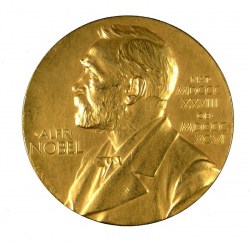During the first week of October, annually, a steady stream of Nobel Prize winners are ushered into the ranks of winners past, with unique stories of the recipients and their achievements littering news outlets and social media.
It appears, however, that differences of opinion plague the public perception of the Nobel Prize, and its very inception was a contentious one.
It is widely believed that Alfred Nobel, the inventor of dynamite, had the nightmarish opportunity to read his own obituary. His brother had recently died, and a French newspaper mistakenly published the notice for Nobel himself — celebrating his demise by coining him the “merchant of death.” As the story goes, the prize was created due to Nobel’s personal anxiety surrounding his legacy.

Alfred Nobel’s profile depicted on the Nobel Prize medal.
Nobel had a vision for highlighting the advancements of individuals in five categories: physics, chemistry, physiology or medicine, literature and peace — based on who “conferred the greatest benefit on mankind.” Yet, in recent years, several op-eds have been published condemning the award and branding it an absurdity.
This year, two historic wins in physics and chemistry were noted when two women — Donna Strickland and Frances Arnold — were recognized for their research concerning lasers and enzymes, respectively. The focus on their wins, after the fact, was more about their newly shared status among a still meager collection of women and less about their research.
In total, 49 women have won the Nobel Prize — with Marie Curie winning the prize twice, once in physics and once in chemistry. The majority of female prize winners are from the literature and peace categories. Only five women have received the prize for chemistry and three for physics, where Strickland’s name now resides.
Strickland is a Canadian optical physicist and associate professor at the University of Waterloo. Her research has contributed to the development of laser surgical techniques, such as the popular Lasik eye surgery. One of the most astounding things about her is that the work she did, which would later secure her the Nobel in 2018, was done when she was still a PhD student.
Since her win, there have been dozens of articles published about Strickland and her research, catapulting her out of obscurity. Back in May, Wikipedia denied a user’s attempt to add a page about her to their catalogue, citing that there was insufficient evidence of notability. This has since been reversed — an entry about Strickland went up 90 minutes after her win.
Among all of this fanfare, the prize itself is heavily scrutinized for its shortcomings. The Nobel Prize has been critiqued as sexist and white-washed — with the majority of its laureates being white males — along with its lone- genius representation of science, as the contributors behind the success of a project leader are rarely recognized.
This narrative was infused into Strickland’s win when the story emerged of her status as an associate professor. Because Strickland is not a full professor, it was automatically assumed by many on social media that she was being held back in her academic advancements. Yet, Strickland has said that is frankly not the case. In an interview with the Waterloo Region Record, published on Oct. 5, Strickland revealed that she never applied for the promotion.
She goes on to say that she didn’t see any value in the process of seeking the promotion and states that she only does what she wants to, and this, she adds, was simply not worth doing. Her response speaks to larger faults in academia, professorship and tenure — just not in the same way it was framed by speculators on Twitter.
All systems have their flaws. Though still grossly under representative among the laureates, there already appears to be a shift towards recognizing the accomplishments of both women and people of colour. There is, of course, much more work needed to even out the scales, but in time, we can hope to see more diversity among the list of winners.
Still, it is argued that the scientific process is skewed by the award. Science is inherently collaborative, yet the prize focuses on one contributor to the field while snubbing the others who might have also broken ground on certain projects.
This is something that won’t be easily overhauled, as I doubt the foundation will hand out honourable mentions. However, the Peace Prize is often awarded to whole organizations, and this could perhaps be a model for more inclusive recognition among the sciences.
The winners of the Nobel Prize become positive representatives of their fields, bringing attention to the work of others, and hopefully, they are capable of such a responsibility.
Despite the faults of the prize, in the end, it is a soft win for science communication. The attention to science research this past week was incredible, with dozens of media outlets publishing hundreds of articles and segments on the subject. If one person learned one thing about science during this popularity contest, to me, that is a positive step forward.
—
Erin Matthews / Opinions Editor
Photo: Royal Karolinska Institute / Supplied